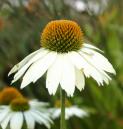OLEUM CROTONIS, B.P.
CROTON OIL.
Croton oil (Oleum Tiglii, U.S.P.) is obtained by expression from the seeds of Croton Tiglium, Linn. (N.O. Euphorbiaceae), indigenous to the Malabar Coast, and cultivated in Southern Asia and China. The oil is expressed in India or England. It occurs as an amber-yellow, orange, or brown, viscid liquid, having a nauseous odour, and a taste at first mild but afterwards sharp and acrid. It is a weak drying oil, and thickens somewhat on exposure to the air. Specific gravity, 0.940 to 0.960 (0.935 to 0.955 at 25°). Slightly dextrorotatory. Solidifying-point, -16°; iodine value, 102 to 109; saponification value, 210 to 215. Adulteration with castor oil increases the specific gravity, lowers the iodine value, raises the acetyl value considerably, and affects the solubility. Hydrocarbons, sometimes used as adulterants, may be detected by distillation in a current of steam, or their amount calculated from the saponification value. Absence of other non-drying oils may be shown by adding one volume of a mixture of equal parts of fuming nitric acid and water to one volume of the oil, and shaking vigorously. It should not solidify, either completely or partially, but may thicken slightly, after standing for two days.
Soluble in less than one volume of absolute alcohol, forming a solution; with an equal volume the solution is turbid, and clear more of the alcohol causes complete separation into two layers, the vesicating constituent being contained in the alcoholic solution. The solubility in alcohol appears to depend upon the proportion of free acids present, and increases with the age of the oil. Soluble in all proportions of petroleum ether (difference from castor oil); freely soluble in ether, chloroform, carbon bisulphide, oil of turpentine, and fixed and volatile oils. Completely soluble in glacial acetic acid at ordinary temperatures. The alcoholic solution should not redden blue litmus.
Constituents.—The composition of the oil is very complex, and the nature of the active principle not yet fully ascertained. It may contain stearic, palmitic, myristic, lauric, valeric, butyric, acetic, formic, oleic, and tiglic acids, and their glycerides. The active constituent is called "croton-oleic acid," and consists of several inactive, oily acids, together with a powerfully vesicant substance named croton-resin, C13H18O4, which is believed to be a lactone, or inner anhydride, of complicated structure. It is a hard, pale yellow, brittle substance, nearly insoluble in water, petroleum ether, or benzene, but readily soluble in alcohol, ether, or chloroform. It has neither basic nor acidic properties, but produces on oxidation with nitric acid a mixture of acids. The vesicating power of the resin is destroyed by boiling with alkalies.
Action and Uses.—Croton oil is an extremely powerful cathartic; in any save the smallest doses it is a powerful irritant of the stomach and intestines, causing violent vomiting and purging, followed by collapse. It must therefore be used with great care, and is contraindicated in feeble subjects, where there is organic obstruction, or in inflammatory conditions of the stomach and intestine. Croton oil is administered on a lump of sugar, or made into a pill with bread-crumb or soap and liquorice powder. Externally, it is a powerful counter-irritant and vesicant; it is used in the form of Collodium Crotonis or as Linimentum Crotonis. Its use may be followed by the appearance of a pustular eruption.
Dose.—3 to 6 centimils (0.03 to 0.06 milliliters) (½ to 1 minim).
PREPARATIONS.
- Collodium Crotonis, B.P.C.—CROTON COLLODION. 1 in 10.
- A powerful counter-irritant and vesicant.
- Linimentum Crotonis, B.P.—LINIMENT OF CROTON OIL.
- Croton oil, 2; oil of cajuput, 7; alcohol, 7. Mix. This liniment has been applied as a powerful counter-irritant in acute laryngitis, phthisis, bronchitis, and joint troubles, but is now seldom used on account of the painful inflammation which may be produced.

